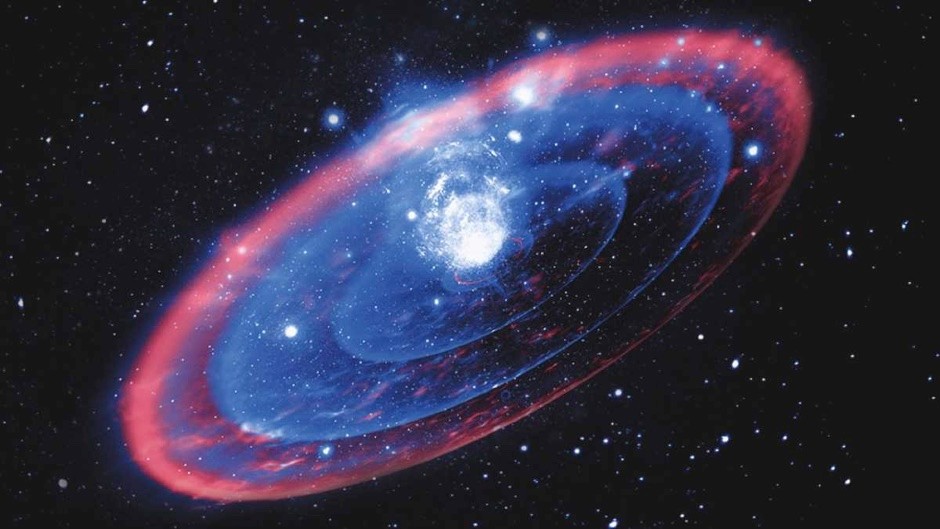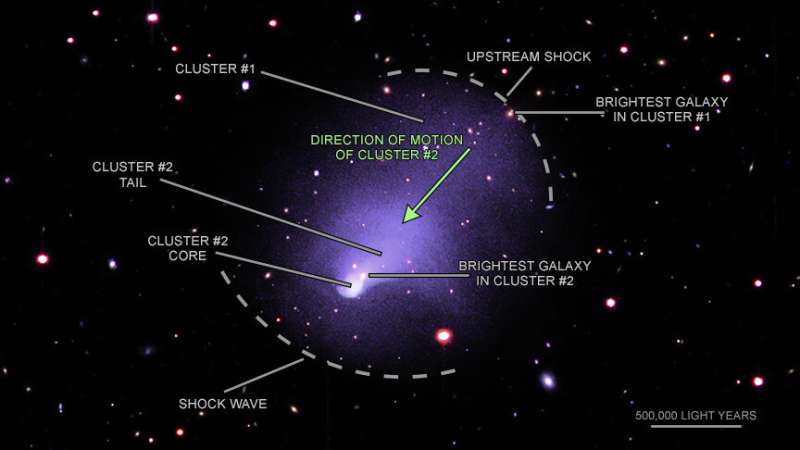The collision of two galaxy clusters Abell 2146 created shock waves in the gas, stretching for hundreds of thousands of light-years. Observation of them has shown that magnetic fields play a key role in their formation.

Scientists observe giant shock waves
Astronomers are observing a pair of galaxy clusters Abell 2146. Each of them consists of hundreds of star systems similar to the Milky Way. And now they are experiencing a dramatic collision, which is being watched by scientists from the University of Nottingham.
Abell 2146 is 2.8 billion light-years away. The collision between two galactic clusters most strongly affects the gas in them. Observations carried out in the X-ray range with the help of the Chandra orbital observatory and studies in the visible and infrared ranges carried out on the Subaru telescope allowed to get a picture of what is happening.
One cluster (it is marked as 2 in the picture) moves through another (1) and a shock wave occurs when a jet of heated gas comes into contact with interstellar clouds. The front of this phenomenon has a length of 1.6 million light-years, that is, it is about 16 times larger than the diameter of the Milky Way.

In this case, cluster 2 is extracted. The core and a large tail are visible in it. Behind the tail, a second shock wave is moving, arising from a complex interaction in the gas.
Mechanism of shock wave formation
The observed picture is very similar to a much smaller, although still gigantic phenomenon. In approximately the same way, gas flows escaping from the surface of the Sun during flares give rise to shock waves in the surrounding gas. And just like the processes on the surface of our luminary with the explanation of the processes in Abell 2146 have big problems.
Both the first and the second have only an external resemblance to shock waves that occur on the Earth, for example, during the passage of a supersonic aircraft. In order for the particles to collide, it is enough to fly about 10 centimeters. Therefore, the main mechanism of energy transfer, which partially turns into thermal, is precisely mechanical interaction.
However, the gas density of Abell 2146 is so small that the particles have to fly from 30 to 50 thousand light years before the collision. Such interaction simply cannot be the main mechanism of energy redistribution.
Scientists have found an explanation for this phenomenon. They analyzed infrared images and came to the conclusion that the main part of the energy to the particles in the shock wave was transferred through their interaction with magnetic fields, generating numerous electrically charged objects in such systems.
Collisions of particles with each other played a more modest role. In addition, they occurred rather slowly. The whole process took about 200 million years. Of course, by the standards of galaxy collisions, which can last billions of years, it’s not long, but it’s still one of the slowest processes known to humans.
According to phys.org
Follow us on Twitter to get the most interesting space news in time
https://twitter.com/ust_magazine

